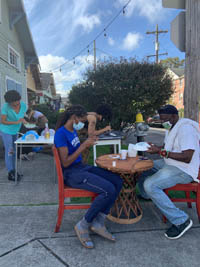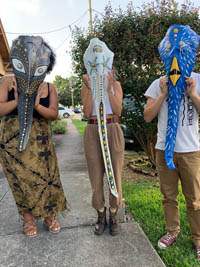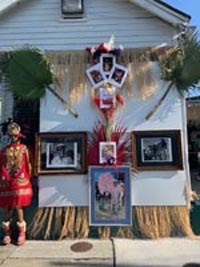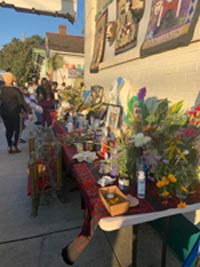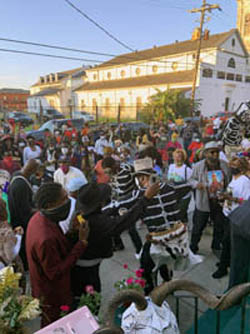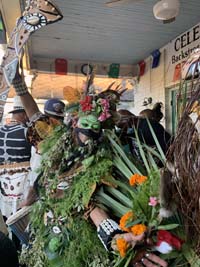Botanica: Traditional Uses of Plants in the Greater New Orleans Area
By Rachel Breunlin, Neighborhood Story Project
and Monique Verdin, Land Memory Bank and Seed Exchange
Portraits by Jonathan Mayers
INTRODUCTION
What kind of medicine grows in your backyard?
During the tumultuous times of 2020, when the entire world faced the heartbreak of loss and the unexpected realities of what the words global pandemic really means, BOTANICA emerged as a series of conversations celebrating a diverse group of naturalists, herbalists, and gardeners with vast plant knowledges found at this very special place known as Bvlbancha (New Orleans) at the end of the Mississippi River.
The BOTANICA conversations are rooted and inspired by the etymology of the Spanish botánica, meaning botany, and less tied to the stores where one can acquire herbal or spiritual supplies. However, we learned throughout our project that the spirit always finds a way in, as the plants and the seasons call community together to celebrate and mourn—to heal, to learn, and to grow.
A maybe over simplified statistic, calculated over time multiplied by disaster and divided by sea level rise, is that every 90-100 minutes a football field of land is lost from the coast of South Louisiana. As South Louisiana continues to lose land at one of the fastest rates on the planet, communities of people, plants, and animals are incredibly vulnerable. So much has already been lost, but this project was led with hope that there is still time to nurture our places with unique biological diversity and strengthen the ties between us.
From the Neighborhood Story Project's old corner store in the Seventh Ward, we hosted a series of interviews via zoom, in the fall of 2020, welcoming United Houma Nation medicine wheel steward Dr. Tammy Greer, mutual aid medicine makers from the Bvlbancha Collective and Maypop Herb Shop folk herbalist Rachael Reeves, naturalist and former interpretive park ranger for the Barataria, Bruce Sunpie Barnes, and Mr. Aloyd Edinburgh and Jenga Mwendo from the Lower Ninth Ward's Backyard Gardeners Network, to the virtual table to talk about plants, community, history and healing, the magic of mycelium and symbiotic networks.
Moments of disaster, be it a hurricane, an 87-day oil spill in the Gulf of Mexico, or a virus, always highlight our basic needs and remind of what really matters. As the world slowed and physical distancing became a priority during the pandemic, many turned to their own backyards to grow their own food for the first time, or to simply recognize the change of seasons. In our conversations, we learned that in the great disruptions of the past, Hurricane Katrina in 2005 being a defining time, many knowledges were also cross-pollinated as people moved to the region to help with the rebuilding. These redirected individual and collective paths continue to ripple throughout communities here in the Mississippi River Delta and beyond.
When conversations across communities are interwoven, both individuals and institutions can act as what Dr. Tammy Greer calls "binding agents." During her interview for BOTANICA, Tammy reflected on her use of sumac in dyeing cloth, and how it has been a metaphor for her broader work developing the Center for American Indian Research and Studies at the University of Southern Mississippi:
There's the plant and there's the material. They're different and they don't just get along just like putting them together. Now isn't that interesting? You can't just put them in the same place and make it happen that they do miraculous things like come out with beautiful cloth. We need a binding agent. I feel like I'm sumac because here I am living in two worlds. I'm living in academic world and I'm living in this other world where I'm working with my tribe and the plants. I think, sometimes, it takes more than just meeting two worlds. I have to scour the cloth, and include a binding agent, to make this work.
Tammy's metaphor resonated with us as it reflected our hopes that BOTANICA would do something similar—bring together remedies from different communities that may not always talk to one another but have a great deal to share.
REMEDIES
Monique Verdin | Land Memory Bank & Seed Exchange
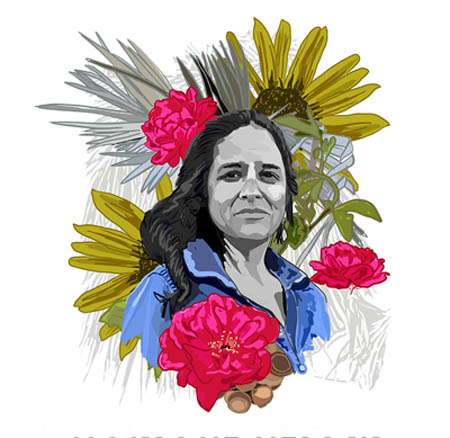
In the Delta, where the land is in relationship to the shifting river, and is in this dynamic state of being born, dying or existing temporarily somewhere in between. It's not an easy place to remember what was once here or know what to invest in so that it will grow in the future. Maybe it won't be here? When I started the Land Memory Bank and Seed Exchange, I wanted to recognize that land in the Delta is always in a dynamic state of being born, dying, or somewhere in between, and yet now this process is greatly accelerated by climate change. I remember how the Houma were mound builders, just like many folks who lived up and down the Mississippi, and dirt mining is still happening here along south Louisiana. Except now, it is not for cities and ceremony but to create earthen levees. To protect ourselves from storms, we're taking the good land, leaving big holes in others. But there are other ways to build up the land—taking what is undesired and making it fertile and rich.
We need space to be experimental. I cannot harvest the sediments and the rich soils from the river, but I've been growing these crazy fields of sunflowers on my family's low-lying land along Bayou Terre aux Boeufs. They will grow to be 15 feet high or more in some cases, and sometimes they just fall over their own. Once they die, then I'll pull them out, and compost them. I'm building new land. Some of the space I'm creating is in my imagination—dreaming about other ways of taking care of the land and the water, and then starting to say to them out loud.

Tammy Greer | Medicine Keeper & Citizen of the United Houma Nation
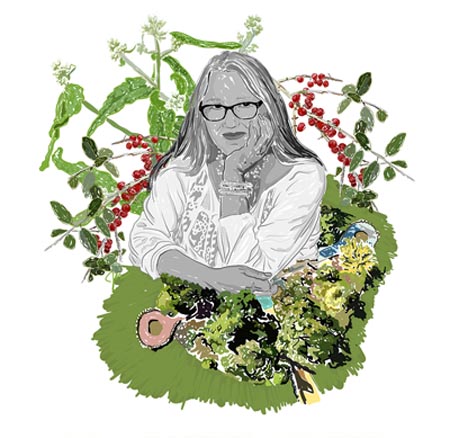
I always like to begin with yaupon holly. We grow it in our medicine wheel. It is full up with good antioxidants that will help your body, as well as neuroprotective, antibacterial and antiviral activity. When it's in bloom, it has four petals on its flower, and in the berries, there are four seeds. To me, the number four reminds us to remember the four directions that oriented and grounded our ancestors.
Yaupon was the foundational drink for the Green Corn Ceremony, which is a religious ceremony most all of the tribes down here practiced. The medicine in there is caffeine, and a lot, a lot of caffeine will make you purge. Just like if you're Catholic and you tap the holy the water before going into a church to give yourself a blessing, you cleanse yourself before a ceremony, or another really important event. When your insides are clean, you have a full cup to receive anything being given to you, and to hear in a different way than if you were all full up with your own ideas.
The Europeans colonized the Southeast, they called it the Black Drink, because when we roasted it, the tea was dark, and gave it the Latin name ilex vomitoria, as if the plant was a medicine to induce vomiting, but that's not true. I harvest the leaves and air dry or pop them in the oven to make a light blonde-roast tea, or I put them in a black pot and roast them with smoke coming in, which gives it a different flavor.
Yaupon is its very most beautiful in the winter because it has red berries only in the winter. On the medicine wheel, that's the time of old age and death. In spite of the cold, or maybe because of, her berries will contain a seed that it may take years to show signs of life. Now think about that, because usually we dismiss people in their old age, and usually we want things happening immediately. What happens if you don't produce right now? But this plant shows us that things happen according to their own design. She is most showy during the winter when everything is not showy.

Rachael Reeves | Co-Founder of Maypop Community Herb Shop
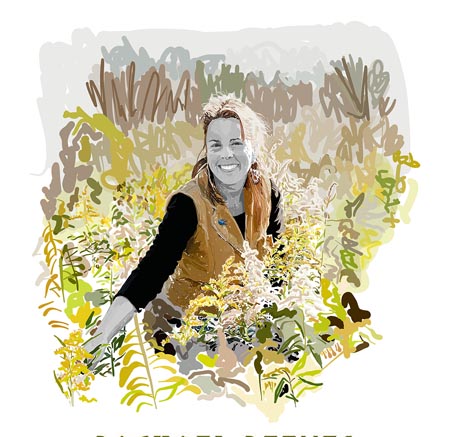
We're in a changing and evolving world that we can protect. We can grow our medicine and food and keep our traditional knowledge intact. When we begin to look towards plants for healing, we can look to the garden variety, the weedy variety—things that are in our own ecosystems and are easy to grow at home. Plants that grow well in South Louisiana include echinacea, elderberry, chamomile, and calendula.
Maypop, the namesake of our herb shop, is the southern word for passionflower. It grows around here very well, and I encourage everyone to get to know it because it's a beautiful remedy. It's very calming to the nervous system, and it can help with anxiety, or for folks who are very cerebral and get stuck in their own head with circular thinking that goes round and round. It helps turn off the noise. Passionflower can also be really helpful for sleep.
It is important to remember that being in nature and working in a garden can be really joyful. Being close to plants, you can learn how joy truly is a big part of our immune system—a big, big part of us feeling whole and in our bodies and supported.

Bvlbancha Collective | Indigenous Community Knowledges

Jenna Mae: The Bvlbancha Collective sees making plant medicine together as an organic expression—a starting place—of ceremony. We have been figuring out that we can do for ourselves while working directly with the plants.
Sasha Irby: Because of our relationality, there is an infinite number of worlds that we're in with one another, and all of those worlds are connected. Plant medicine and community building are really in service to one another—they help us build the worlds that we want to live in.
Ida Aronson: I think we got something going, me and Blue Vervain. It's really great for stressed people, or type A people that need to just chill out a minute. I'm almost out of my whole batch because I have people coming back through the year. There's one grandmother who's my neighbor who is a big fan. She's like, "It's helped me so much."
Jenna Mae: Another plant is cleavers, a weedy plant that will stick to you like Velcro and is a great spring tonic herb that kind of helps flush everything out and get the limbs moving after winter months or after sickness. Seventy-five percent of the medicine we sell goes back to Black and Indigenous people here in South Louisiana and other parts of Turtle Island. Twenty-five percent of it is for sale because we were thinking of ways that we can do for us—to raise funds to help us get to language revitalization conferences, travel for ceremony, and exercise sovereignty on our traditional homelands.
Angela Comeaux: I want to expand the idea of sovereignty outside of physical land and start talking about how much our culture, and everything that we traditionally believed in, is tied to nature. Being able to speak our languages and take care of the land and the water in the way our ancestors did is part of that sovereignty.

Bruce Sunpie Barnes | Mushrooms and Swamp Medicine
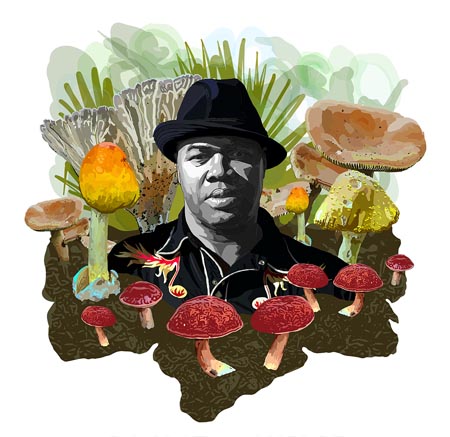
I'm a great believer in knowing and understanding what's in your backyard because you, too, are a local product. I've studied mushrooms since I was a park ranger in the Barataria. One the five kingdoms, they do not use sunlight for nourishment. They don't create their own energy, so they usually create a relationship with other plants. Some are parasitic, and some create symbiotic relationships with trees, bringing water and phosphates from their decaying matter. The tree gives the fungi carbon, and from that decaying matter, they create energy. They also transfer information. One fungi can be communicating with several different trees at the same time because it spreads out on the surface or underneath the ground like a big net. If one tree has a disease, the fungi can send information to other trees in the forest that it has a problem, which prompts those trees to start to create a defense, or they may send more nutrients back to the sick one.
There are many mushrooms found in South Louisiana that are good medicine for people too. We have a number of jelly mushrooms in the Auricularia family that you can find it in Chinese soups and have antibodies that are good for our kidneys. Other ones like Lion's Mane are good for memory and help alleviate anxiety and depression. Some are just delicious to eat—the wetlands are full of oyster mushrooms in the cooler months of fall and spring, and chanterelles in the hot, steamy months.

Jenga Mwendo and Aloyd Edinburgh | Backyard Gardners Network of the Lower Ninth Ward

Jenga: Mr. Aloyd has been a big inspiration to me. He doesn't have any land in his front yard or in back of his house. He grows everything out of containers he built himself. He grows peppers, tomatoes, and greens. He's even got peach trees in a container.
Mr. Aloyd: I always like to grow flowers.
Jenga: Like a lot of the other elders in the Lower Ninth Ward, growing is just a thing that you do. You don't have a special name for it. We don't call it urban agriculture.
Mr. Aloyd: I used to give mine to the old people in the neighborhood. They living by themselves, so I just give them away. From your own garden is better than the store.
Jenga: The Backyard Gardeners Network developed to help that cultural tradition to thrive and maintain and bring us together around food. In a small way, our gardens have helped to make our neighborhood stronger.

A CONSOLING NARRATIVE: BOTANICA AT ALL SAINTS DAY
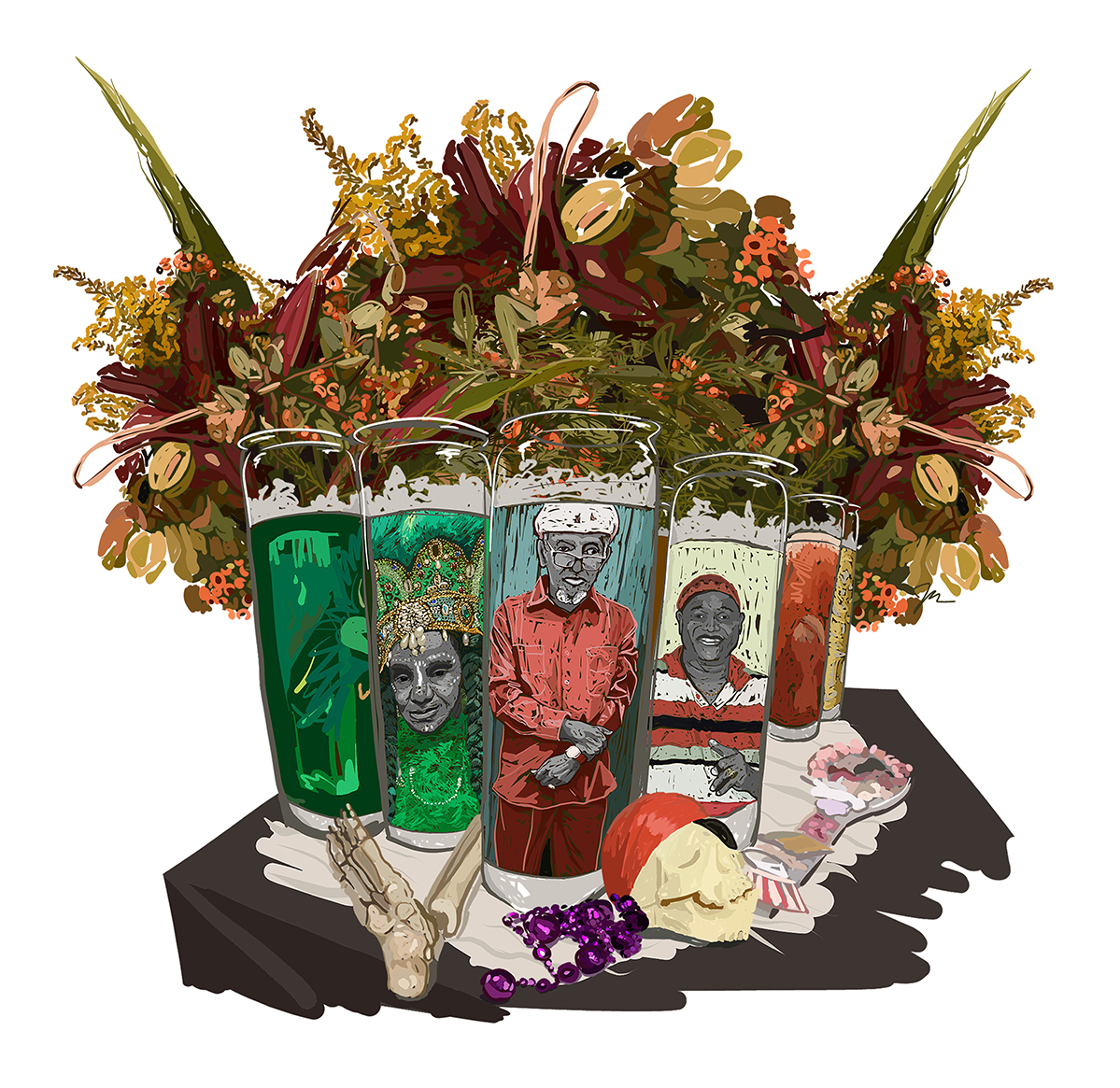
While Botanica focused on gardens and the importance of understanding medicinal plants in south Louisiana, we also wanted to highlight how flowers and other plants are central to the creation of altars that are created in the region. During the Fall of 2020, a deep sorrow ran through our communities as we struggled with the grief of the coronavirus pandemic and the loss of loved ones due to gun violence. The sadness was compounded by the stress of an extremely dangerous Atlantic hurricane season, which included 27 named storms. Five of the storms—Cristobal, Marco, Laura, Delta, and Zeta—made landfall in Louisiana. According to the National Hurricane Center, the most ever recorded in a single state. As we prepared for the storms, we also worked with the Backstreet Cultural Museum to organize an All Saints Day altar to honor our ancestors and loved ones who have recently passed away. In The Well Gardened Mind: The Restorative Power of Nature, Sue Stuart Smith explains how flowers can be an important bridge in reconciling life and death:
Flowers may well have provided our remote ancestors with the first consoling narrative. When self- consciousness emerged in human prehistory, it brought with it an experience of separation and an awareness of mortality. These existential predicaments have been with us ever since, raising age-old questions: How to make sense of life? How to deal with the pain that comes from living? The life of a flower offers us something to hold on to, as a form of protection against fears of fragmentation in the face of death. Ephemeral and fragile as flowers are, they are the agents of continuity. For the flower in its beauty is destined to die, that its fruit may live and bring forth more flowers from seeds (Stuart 2020: 144).
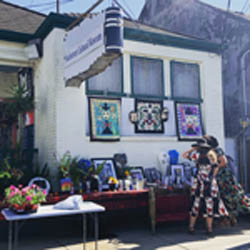
The founder and director of the Backstreet, Sylvester Francis, had been hosting a celebration for All Saints since the late 1990s. In September, he passed away from complications from appendicitis. As we came together to plan an All Saints Day event to honor Sylvester's legacy, we faced concerns with how we could have an event that would keep everyone safe from both the pandemic, and the weather. Socially distanced and wearing masks, Rachel's students in her Public Culture worked with the Big Chief of Fi Yi Yi, Victor Harris and his master designer, Jack Robertson, to prepare artwork made of palm fronds, and we planned an altar with Sula Evans, priestess of the Temple of Light Ilé de Coin Coin. who is also the medicine queen of Fi Yi Yi. Bruce Sunpie Barnes, the big chief of the Northside Skull and Bone Gang and president of the Backstreet, created a musical program with the Treme Brass Band and Fi Yi Yi.
In the week leading up to All Saints, Zeta made landfall as a category two hurricane, which left 2.1 million people in the Gulf Coast without power, including most of New Orleans and the surrounding area. As All Saints is normally celebrated by candlelight, we decided to move on with our event, and invited our Botanica collaborators to join us in preparing the altar. We built it under the bright sunshine and blue skies that always seem to follow large storms. Rachael Reeves harvested palms and other greenery from her garden, Jenna Mae from the Bvlbancha Collective brought a smoke cleanse bundle for Sylvester's family, and we worked with educator Renee Rednour who brought large bouquets from her flower garden in Gentilly.
Guests from around the region began arriving and leaving photographs and memorial objects for loved ones. Monique Verdin offered a blessing of the river and recognition of the Indigenous nations who lived and continue to live in the region, Sula Evans gave an ancestral blessing, and the families of the recently departed spoke of their legacies.
The Treme Brass Band played dirges from the porch of the museum, and grand marshal Oswald "Bo Monkey" Jones made a small procession down the stairs dressed in a black suit. He held out his hat out as if to say, "I will take the sorrow you feel, give it to me." Many people cried at being able to commune in the moment with live music. One guest said she had not realized how much she missed it—how it was so fundamental to how we express our individual and collective sentiments—until she heard it again.
Down the street, the polyrhythms of hand drums were building, and the crowd turned to see the Northside Skull and Bone Gang, dressed in skeleton masks, headed towards the Backstreet accompanied by the Spirit of Fi Yi Yi wearing a painted, wooded mask with cowrie shells and Resa "Cinnamon Black" Bazile, dressed in ferns and marigolds. Since the murder of Kim Boutte in the summer of 2020, the role of big queen has passed on to her. Amongst the crowd, Fi Yi Yi held a palmetto frond and danced with her and the skeletons. Together, we danced in a moving garden.


